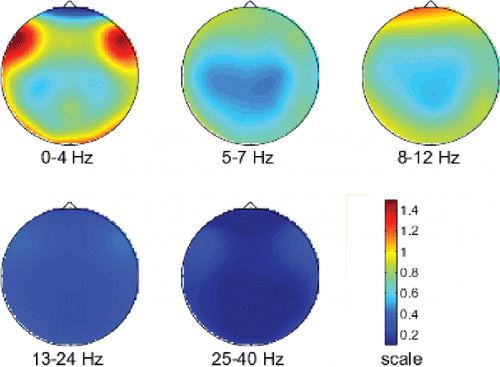Figures & data
Figure 1. Topographical maps of EEG activity in in frequency ranges of interest in a patient sample with AD.

Table 1. Number of observations for the different factor level combinations.
Table 2. Multivariate analysis of EEG data. Factors age (⩾ 70), diagnosis (AD, MCI, SCC), and sex. WTS is the Wald-type statistic approximated by a χ2-distribution, PBS denotes the asymptotic model-based “parametric” bootstrap.
Table 3. Multivariate analysis of EEG data using classical methods. Factors age (⩾ 70), diagnosis (AD, MCI, SCC), and sex. PBS denotes the p-value from the parametric bootstrap of the WTS.
Table 4. Three-way layout for SPECT data. Between-subjects factors sex and age. Within-subjects factor brain region. WTS is the Wald-type statistic approximated by a χ2-distribution, PBS denotes the asymptotic model-based “parametric” bootstrap.
Table 5. Three-way layout for SPECT data. Between-subjects factors sex and age. Within-subjects factor brain region. PBS denotes the asymptotic model-based “parametric” bootstrap, for comparison.
Table 6. Multivariate analysis of SPECT data. Factors age (⩾ 70), diagnosis (AD, MCI, SCC), and sex. WTS is the Wald-type statistic approximated by a χ2-distribution, PBS denotes the asymptotic model-based “parametric” bootstrap.
Table 7. Three-way layout for SPECT data. Between-subjects factors sex and diagnosis. Within-subjects factor brain region. WTS is the Wald-type statistic approximated by a χ2-distribution, PBS denotes the asymptotic model-based “parametric” bootstrap.
Table 8. Marginal effects/repeated measures analysis. Four-way layouts for EEG data. Between-subjects factors sex and diagnosis (AD, MCI, SCC). Within-subjects factors brain region (frontal, central, temporal) and feature (brain rate, complexity). WTS stands for the classical Wald-type statistic approximated by a χ2-distribution, whereas PBS denotes the asymptotic model-based “parametric” bootstrap procedure.
